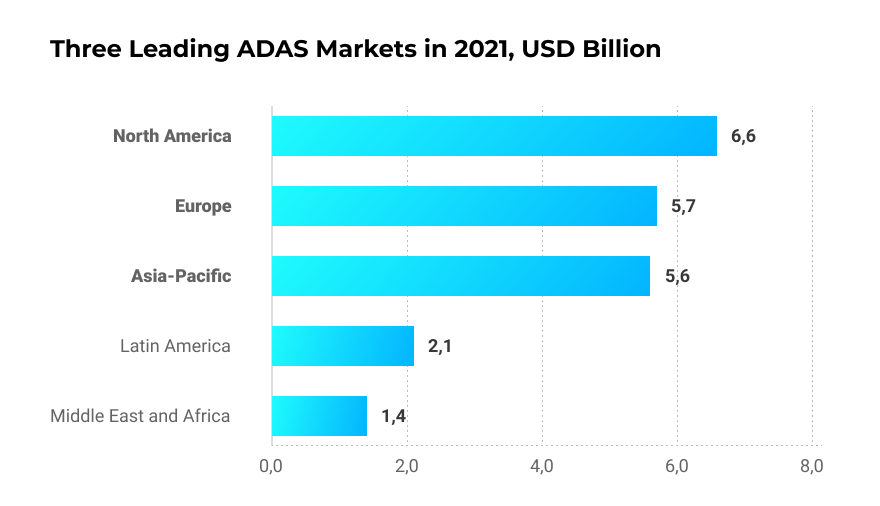Car makers address road safety problems by introducing new ADAS features to their vehicles. Governments and NGOs support these endeavors with new legislation and standards. Let’s look closer at both major ADAS markets with their trends and regulations, as well as at successful ADAS use cases. For the technical side of ADAS systems, check out our previous article.
Market Overview and Regulations
High demand for safety (and comfort) features while driving fosters ADAS vehicle market growth. Stringent safety rules and regulations also contribute to this trend. To understand the scope of its growth, consider these figures: in 2018, the global advanced driver-assistance systems market size was valued at $40 billion, and by 2026 it is expected to reach 180 billion.
It’s clear that autonomous driving systems are key to current and future markets; 15% of cars sold in 2030 forecasted to be fully autonomous. So, by 2035 there will be about 95 million autonomous cars sold annually.
Regional Trends
North America
North America dominates the overall ADAS market. The U.S is the leading country in the North American region due to its extensive research and development facilities, which have made significant investments in smart automotive production methods and process automation. This market is also being driven by the rising awareness of road and vehicular safety.
The US government regulates many ADAS systems in new vehicles, such as adaptive cruise control, rear cross path detection, and front pedestrian detection. Additionally, the Insurance Institute for Highway Safety (IIHS) announced that Automatic Emergency Braking (AEB) will be included in all new passenger vehicles by 2022.
Europe
Europe is the second leading ADAS market. The Euro New Car Assessment Programme (NCAP), the EU’s safety certification body, has been working towards increasing the adoption of advanced safety techniques since 2010. It states that cars integrated with ADAS systems will be awarded the top safety rating of five stars.
Some ADAS systems are already mandatory in the EU. For instance, Electronic Stability Control (ESC) has been required since 2014. AEB became compulsory on all commercial vehicles in 2015. The European Commission has published a list of new mandatory safety features for 2021. They include: advanced emergency braking, accident data recorder, emergency stop signal, head impact zone enlargement for pedestrians and cyclists, safety glass, and lane-keeping assistance.
Asia-Pacific
Asia-Pacific is the third leading global ADAS market. It is expected to grow the fastest thanks to increased vehicle production in India and China and the growing number of luxury vehicles across the region. Stringent government regulations in Asia-Pacific countries will also lead to higher adoption of ADAS systems. As of today, some ADAS solutions are already mandatory for all new vehicles produced in the region. They include: blind spot detection, adaptive cruise control, and lane departure warning systems.
ADAS Use Cases
- Adaptive Cruise Control
Adaptive cruise control is an intelligent system that allows drivers to maintain optimum distance between vehicles while driving and enables vehicles to automatically adjust their speed while approaching other vehicles.
The system is based on an onboard radar or a laser sensor that is integrated with the engine as well as the brakes of the car so that when the system detects any vehicle in its roadway, it automatically slows down and then reaccelerates to the set speed when the path is clear.
Among major car manufacturers, BMW, Honda, Nissan, and Ford already offer adaptive cruise control systems. This helps lessen the stress of driving, especially for those with long commutes through busy urban areas.
- Lane Departure Warning System
This system helps the driver keep their vehicle in its lane and reduces on-road collisions. It uses a small camera mounted near the rearview mirror to recognize the striped and solid lane markings, so whenever the vehicle starts deviating from the lane without an appropriate turn signal, an alarm is triggered.
Statistics show that lane departure warning alone can prevent up to 7% of all accidents with injuries and fatalities. Today, the systems are available on two-thirds of new U.S. passenger vehicle series, rarely as standard and usually as optional equipment.
- Collision Warning System
Collision warning systems notify the driver in case of forward collision with any other vehicle or object in the roadway. They work on integrated radar, laser, and camera systems to generate audio, visual, and tactical alerts. These systems measure the distance, angular direction, and relative speed between the two vehicles. Some of the forward collision warning systems are integrated with the adaptive cruise control systems to slow the vehicle speed when any vehicle is detected in front or nearby.
According to the US National Traffic Safety Administration, at least 20 major car manufacturers will make collision warning systems a standard feature by 2022. While these systems don’t prevent every accident, they have been proven to significantly mitigate collision risks.
- Parking Assistance System
This system senses the distance between the vehicle and surrounding obstacles. Its ultrasonic sensors fixed on the front and rear bumpers of the vehicle detect obstacles while parking and trigger proximity alarms. The rear camera is also integrated with the system to provide visual assistance while parking.
According to Bosch analysis, every other new passenger car today is equipped with some kind of parking assistance system—from parking sensors to automated parking technology, and this share is growing exponentially.
- Night Vision and Pedestrian Detection
Pedestrian detection systems with night vision are equipped with thermal cameras and far-infrared sensors that capture thermal radiations from the front of the vehicle and distinguish living beings from objects, trees, and traffic signs on roadways.
Progressive automotive companies like Toyota, Tesla, and Honda are implementing high-precision AI-based and computer vision pedestrian detection technologies to detect human movements ahead and alert the driver. Some may automatically apply the brakes.
- Tire Pressure Management System
Tire pressure monitoring systems (TPMS) are critical ADAS systems, as they warn the driver if any tire is under-inflated. Tire pressure is a critical parameter in ensuring vehicle suspension and safety on the road. Uneven tire pressure can create mileage issues, more emissions, and reduced tire tread life, and it can even cause tire failure, which may result in serious road accidents.
There are two types of TPMS. Indirect TPMS measures the tire’s revolutions per minute (RPM) and alerts the driver of any unexpected RPM. Direct TPMS are pressure sensors attached to each tire, which provide actual readings.
The global market for TPMS is projected to reach $21 billion by 2025. It’s driven by tire pressure safety regulations and the overall electronification trend that makes TPMS a starting point for the development of truly electronic tires of the future.
- Traffic Signs Detection
Real-time traffic sign recognition (TSR) systems help drivers follow both traffic signs and traffic rules. In-vehicle TRS systems are equipped with forward-facing cameras to detect on-road signs. Real-time feeds from front cameras with image processing, computer vision, and image recognition algorithms help the system recognize traffic signs. Then, the system displays them on the infotainment screen to the driver.
The system is quite common in Audi and Mercedes S- and E-Class, and BMW offers it as an option as well. Volvo, which is always at the forefront of safety systems, offers the system either optionally or as standard depending on the car model.
Case Closed
The automotive industry has long been a place for innovative driving and safety solutions. Today, the industry is gearing up to deliver even more sophisticated products equipped with even more advanced features. Countries are now mandating more features at the legislative level to improve safety on the roads.
Section title
More articles on the topic








